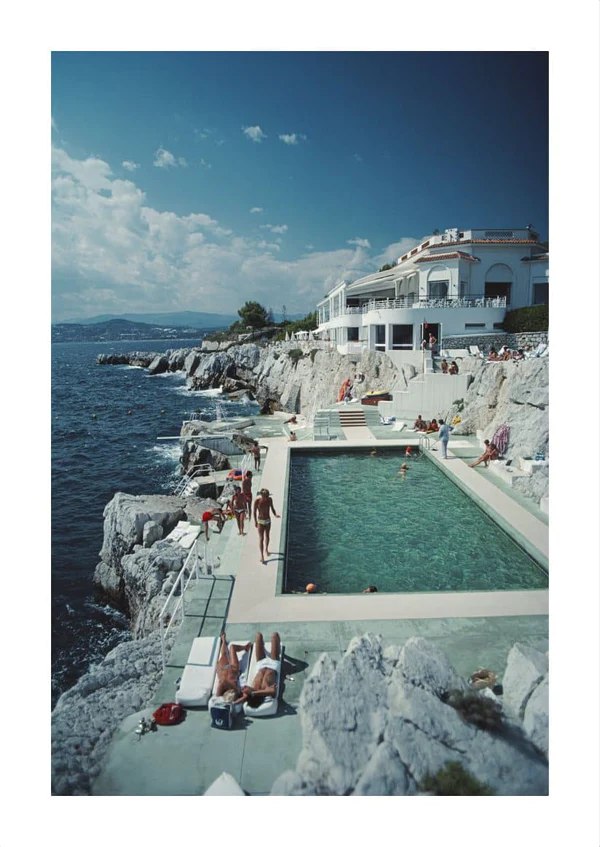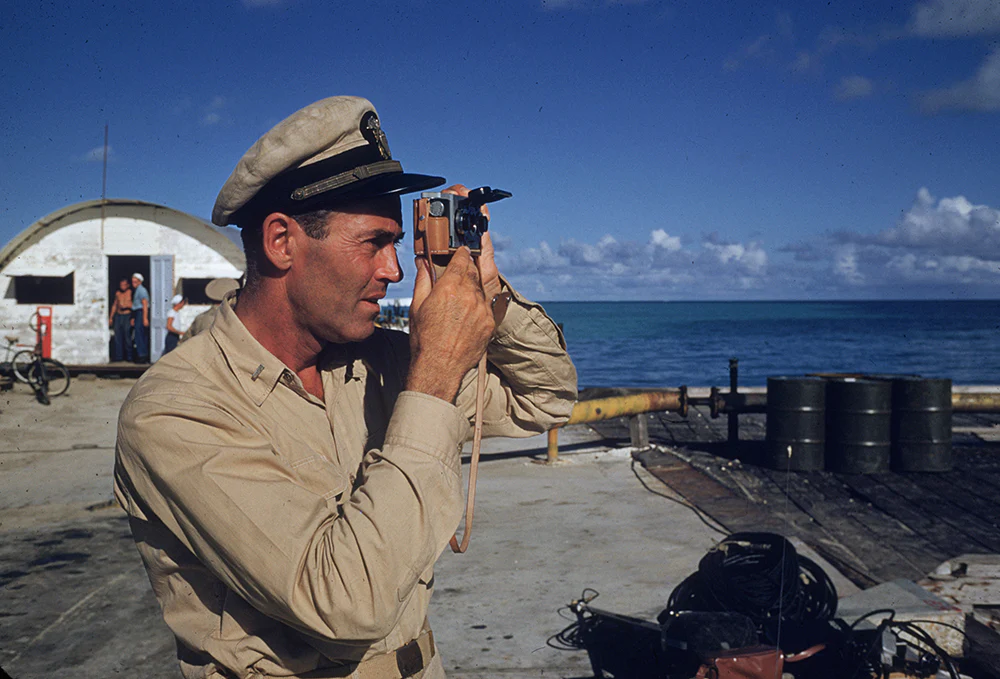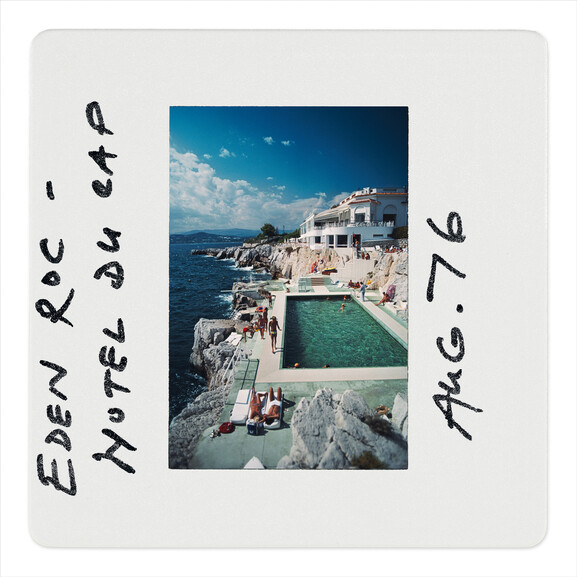As summer approaches, this appraisal of the American photographer Slim Aarons’ iconic 1970s image of the exclusive swimming pool and clientele at the Hotel du Cap, Eden Roc on the French Riviera, reassesses its historic perspective.
‘Slim was an anthropologist with his camera. He documented an entire era.’[1]
Aarons’ Aesthetic
Slim Aarons’ Leica camera captured this evocative image at exactly 4.30 p.m. on a soporific summer’s afternoon at the Hotel du Cap, Eden Roc. [2] A privileged international jet-set of about thirty, sun tanned, white people lounge around this mesmerising scene. The only person fully dressed is the pool attendant, diminished by his pale blue trousers, long-sleeved shirt and crisp white shoes. Everyone else is barefoot, sporting swimwear.
Aarons, an aesthetic genius, showcased class and an old-monied lifestyle where financial worries were few and luxury and leisure prevailed. Where conversations were an exclusive and sophisticated form of networking, finessing business deals including marital match making or heart breaking.
Such relaxation signalled immense wealth. For workers thwarted by the global oil crisis, the British three-day week and the economic residue of the miners’ strikes of 1973 and 1974 which brought down Edward Heath’s Conservative government, this carefree lifestyle would have been inconceivable. [3] Moreover, Ben Lewis’ documentary Welcome to Britain focused on immigrants from India, Pakistan and Cyprus who were ‘treated like criminals’.[4] Britain’s crowded beaches, despite the soaring temperatures achieved in the summer of 1976, paled again Aarons’ photographs of escapist holidays which were distributed in glossy magazines.
Aarons’ Origins
Aarons’ childhood had been difficult. His impoverished Jewish parents lived in the Lower East Side of Manhattan and consequently he often claimed that he was orphaned. His lucky break came when he was serving in the United States Army’s photographic team. There he met and impressed the movie director Frank Capra who was directing A Prelude to War (1942) at West Point.[5] After which Aarons was sent to Europe as a combat photographer in Italy in World War II and awarded the Purple Heart when injured saving a friend’s life. In peacetime, Aarons moved to California,[6] thereafter, finding his purpose ‘photographing attractive people doing attractive things in attractive places’.[7] Defining his career, he famously said, “I felt I owed myself some easy, luxurious living to make up for the years I had spent sleeping on the ground in the mud, being shot at and being bombed.”[8]
A Brief History of the Hotel du Cap
This image — one of several from the same photo shoot — was inevitably titled Hotel du Cap Eden Roc, the name of its location at the French Riviera’s languorous chateau. The hotel was picturesque, set atop a jagged rock promontory and discreetly hidden within vast acres of pine groves. The elegant, long, low, white Art Décor tiered building shown in the photograph is not the main hotel building but is simply a pool house.[9]
Styled as an hotel in the 1880s, the venue became a playground for those whose wealth or celebrity demanded seclusion: heyday movie stars, royalty and acolyte aristocrats. Aarons’ presentation of their sophisticated milieus served to enhance an aspirational post-war lifestyle.
An Aspirational Lifestyle
Aarons’ artistry leads the eye through a refined composition made cohesive through the trailed bone- to gleaming-whites and tranquil blue palette. Nothing jars the pervasive sense of sun-soaked serenity, not even the orange and yellow flashes of inflatable dinghies and red life rings.
A man and woman sunbathing on the lower left of the photograph foreground this visual effect. Their designer shoes and branded flight bag lie casually abandoned. Throughout the setting the towels, sun-loungers and sun umbrellas are a dazzling, expensive, white.
The aquamarine swimming pool is the key feature, designed as a stark, hard edged masculine rectangle which was cut into the concrete-coloured basalt rock. A sinuous architectural contour later softened the original sea-edged coast line.
Five horizontal terrace steps delineate the mid-ground, carefully separating the larger visible pool from a smaller pool, possibly reserved for children because white foam life boards float across its surface. Although whether children were welcomed to this unfettered adult ambiance is doubtful. Brave swimmers might carefully venture into the Mediterranean Sea via steep cliff side ladders or precarious diving boards.
The upper section of the photograph draws the gaze along the hewn rocks of the coastline towards the solidity of the pool house and beyond along the promontory, past a mature tree towards a precipitous fall into the dangerous deep blue waters. Soaring mountains rise across the bay and above them an azure blue sky banks moody clouds.
Aarons’ Allegory?
Perhaps the contrast between the swimming pool and the Mediterranean Sea was Aarons’ nuanced allegory of the public and private faces of humanity? The swimming pool is a sanitised, forensically maintained vessel for conspicuous public indulgence, contrasting with the Mediterranean Sea’s hidden variable depth and periodic character. Aarons was a pleasant, charming and urbane man who was capable of smoothing the anxieties of his photographic subjects. Yet Aarons’ origins could have frustrated his inclusion in these elite spheres.
Today, should we consider the taking of this photograph as voyeuristic? Aaron enjoyed spaces ‘decorated with beautiful semi-nude girls tanning in a tranquil sun’.[16] Had the women who were photographed topless in this photograph given their permission? Doubtful in a bygone age.
Peer Photographers
Aarons’ outdoor oeuvre most closely resonated with the work of the French photographer Jacques Henri Lartigue,[10] whose whimsical black and white images captured carefree society at play. Alternatively, the constructed fantasies of British photographer and royal favourite, Cecil Beaton,[11] and more formally, the work of the German American photographer, Horst P. Horst,[12] who posed models as Greek goddesses often in artificially illuminated interiors. Comparably, the work of British photographer, Norman Parkinson,[13] whose later society and fashion photographs were frequently published in Vogue. Their bon vivant style juxtaposed against the evocative gritty social themes of photographs taken by Americans, Mary Ellen Mark,[14] or the ‘gallery of misfits’ portrayed by Diane Arbus.[15]
The Glorified Rich
Compellingly, this exclusive photograph documents a European social history which package holidays for the populus sought to emulate. Aarons, who considered himself a farm boy and returned home swiftly after assignments, said that he ‘merely enjoys creating the opportunity for the economy class to stand in awe at the glorified rich’.[17]
Citations
[1] https://www.townandcountrymag.com/leisure/arts-and-culture/a7633/slim-aarons-life-story/, accessed 7 June 2023.
[2] George Allen ‘Slim’ Aarons (1916–2006). In 1997 Getty Images purchased Aarons’ entire archive. Also see, Aarons, Slim (1974) A Wonderful Time: An Intimate Portrait of the Good Life. Harper and Row, New York
Aarons, Slim (2003) Slim Aarons: Once Upon a Time. Harry N. Abrams, New York. And, https://fineprintco.com/en-uk/blogs/news/10-things-you-didn-t-know-about-slim-aarons, accessed 7 June 2023.
[3] Edward Heath (1916–2005). https://www.gov.uk/government/history/past-prime-ministers/edward-heath, accessed 7 June 2023.
[4] Groskop, Viv. 2016. ‘Was the Summer of 1976 the best Britain ever had?’. https://www.theguardian.com/society/2016/jul/30/was-summer-1976-best-britain-ever-had, accessed 06 June 2023.
[5] Frank Capra (1897–1991). https://fineprintco.com/en-uk/blogs/news/10-things-you-didn-t-know-about-slim-aarons, accessed 7 June 2023.
[6] Martin, Doulas. 2006, ‘Slim Aarons, 89, Dies; Photographed Celebrities at Play’, New York Times. p. A23. https://www.nytimes.com/2006/06/01/arts/01aarons.html?mcubz+0, accessed 06 June 2023.
[7] Martin, Doulas. 2006, ‘Slim Aarons, 89, Dies; Photographed Celebrities at Play’, New York Times. p. A23. https://www.nytimes.com/2006/06/01/arts/01aarons.html?mcubz+0, accessed 06 June 2023.
[8] https://fineprintco.com/en-uk/blogs/news/10-things-you-didn-t-know-about-slim-aarons, accessed 7 June 2023.
[9] https://www.telegraph.co.uk/travel/dsetinations/europe/france/cote-d-azur/hotels/hotel-du-cap-eden-co/-accessed 06 June 2023.
[10] Jacques Henri Lartigue (1894–1986).
[11] Cecil Beaton (1904–1988).
[12] Horst P. Horst (1906–1999).
[13] Norman Parkinson (1913–1990).
[14] Mary Ellen Mark (1940—2015).
[15] Diane Arbus (1923—1971). https://www.timeout.com/newyork/art/top-women-photographers, accessed 16 June 2023.
[16] Martin, Doulas. 2006, ‘Slim Aarons, 89, Dies; Photographed Celebrities at Play’, New York Times. p. A23. https://www.nytimes.com/2006/06/01/arts/01aarons.html?mcubz+0, accessed 06 June 2023.
[17] https://fineprintco.com/en-uk/blogs/news/10-things-you-didn-t-know-about-slim-aarons, accessed 7 June 2023.





